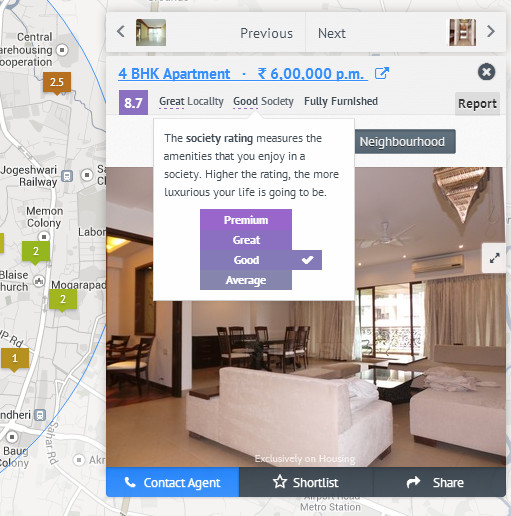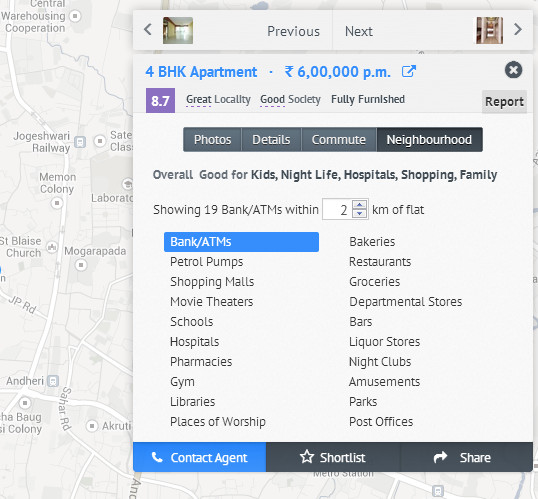Imagine yourself digging around for a nice cool apartment in Mumbai. You go through the various listings, shuffle through the apartment pics, and finally decide to shift to a new flat. But only after a couple of days living in this new apartment, it seems the picture isn’t that rosy. The beautiful flat that you were promised is there, but other unforeseen problems begin to rear their ugly heads. Maybe there is no drug store nearby to get medicines in an emergency. Or there is one down on the main road, but the poor roads connecting you to that highway are potholed and already disappeared underwater due to heavy rains. The kids need to spend their evenings playing out, but instead of a nice green park you are greeted with a colony of slums thriving in abundance. This is the moment you realize that somewhere, the choice you made went wrong.
Well, not anymore. Our newly established Data Sciences Lab has churned up several algorithms that will make sure that the next choice you make never goes wrong!
Housing LifeStyle Rating
To enable users to choose better, we devised a carefully structured algorithm that quantifies the overall experience of living in a given apartment. The algorithm takes into account the most basic needs and sought after luxuries, and weighs them according to their importance. It was realized that an apartment could be rated using four verticals of primary importance –
- Location of the house
- Amenities provided by the Society itself
- Facilities in the neighborhood of the house, and
- Connectivity of the house to the world outside
Several factors had to be considered while imparting individual scores to each of these verticals. The algorithm in place uses around 50 such parameters. These ingredients then go into the recipe that churns out the Housing LifeStyle Rating – a number that stands for all those other tidbits that actually define the experience of living. The final product of the algorithm – the rating, will be a number ranging between 0 and 10.
- 9-10: Excellent
- 8-9: Great
- 7-8: Good
- 4-7: Average
- <4: Poor
You can also arrange flat results according to Housing LifeStyle Rating. All you have to do is click on ‘Arranged by’ and then ‘LifeStyle’. Flats will be color coded in ascending or descending order based on their HLR.
HLR is an aggregate of 4 different verticals. These 4 verticals themselves are fully developed algorithms which enhance understanding of the locality, society, connectivity and neighborhood aspects of a flat.
Locality Score
The first of these verticals is the locality. Waking up to see a lush green space around the house has a very different impact on a person’s day than a run-down locality with slums and filth strewn all around. The Locality Score inevitably finds its way into the algorithm depending on the quality of the surroundings. While a slum will pull the score down, a sea-facing apartment in Worli or an independent bungalow in Malabar Hills will push it up. But the algo also meticulously takes into account the presence of airports and railway stations/bus stops – the former a curse owing to the noise they generate, the latter a blessing for cheap public transport in the vicinity. Based on the score, societies have been categorised as Premium, Great, Good, Average and Poor
Society Score
A look closer home reminds us of amenities that form a crucial part of life every day. The presence of a gym, a swimming pool, a spacious parking lot, a park, good sports facilities and the like, go a long way in ensuring a certain quality of living, and a higher Society Score. All these amenities are weighed depending on their frequency of use and importance – such as a parking lot is of primary importance that will certainly be used everyday by folks owning vehicles. Moreover, the rating takes care of all age groups – with separate weights for playing areas and parks for kids; bars, restaurants, pubs for youngsters and temples, churches for elderly. Based on the score, the societies are classified into Premium, Great, Good and Average.
Neighborhood Score
A glance further down the road reveals a bunch of facilities that are not all that close to the house, and yet indispensable. Easy access to the neighborhood facilities like the grocery store, the hospital for medical aid, or the nearest nightclub after a stressful day is an added advantage for the apartment – and is taken into account through the Neighborhood Score. The algorithm tells you whether a particular flat is good or bad for Family, Hospitals, Restaurants, Shopping and Nightlife.
Connectivity Score
Finally, the algorithm comes down to the last vertical, which is of prime importance. What good are all those facilities and peripheral amenities if there is no good road network to connect the house to them? And what good is it if there’s no Bus and Train connectivity nearby to connect you to the rest of the city? Connectivity Score tells you how well connected a particular flat is to the road, the nearest bus stop and the nearest railway stations. This finally tops off the entire cooking process for the HLR of the apartment.
What HLR is not
After a look at what the HLR is all about, it seems important to mention also what it’s not. Being a quantifiable rating as it is, it solely describes the quality of life in a given locality, not the quality of the house itself. For instance, there could be a house which is only poorly furnished and yet enjoys a ‘Good’ lifestyle rating owing to its safe and secure neighborhood, and parks and ample greenery in its vicinity. The quality of life in such a house might possibly outweigh its shortcomings of having a dull interior. Conversely, there may also exist a sparkling well-furnished apartment with an ‘Average’ lifestyle rating that could be attributed to its poor connectivity. But higher scores in the other verticals combined with a wonderful interior could make the choice totally worth it. The lifestyle rating merely quantifies the quality of life, thereby bringing other significant parameters into the picture.
With HLR, the way you hunt for houses will change. Yet again! HLR is now available for all cities on Housing. Go on, check how your home fared!












